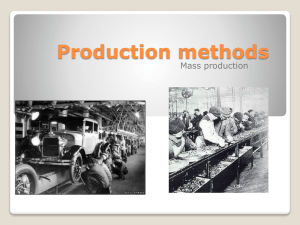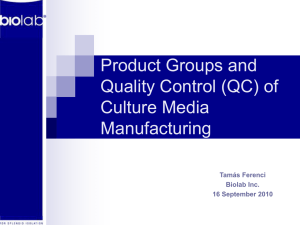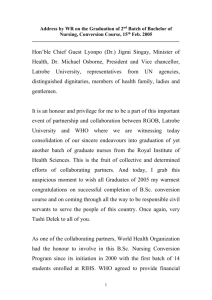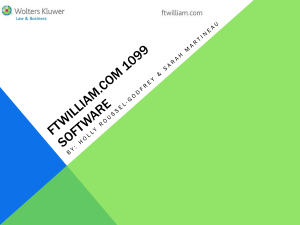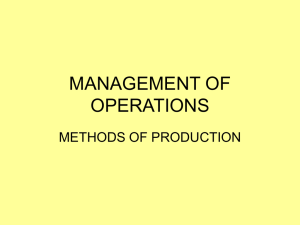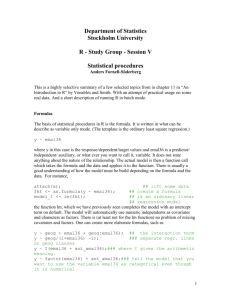Quality Overall Summary - Product Dossier (QOS-PD)
advertisement
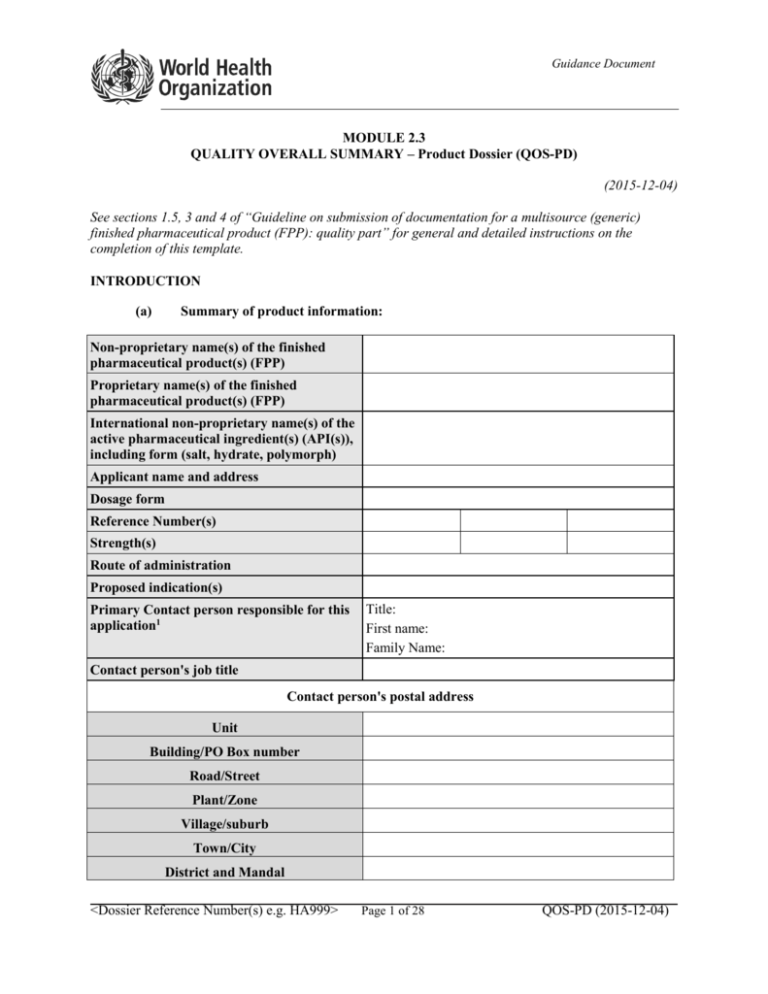
Guidance Document MODULE 2.3 QUALITY OVERALL SUMMARY – Product Dossier (QOS-PD) (2015-12-04) See sections 1.5, 3 and 4 of “Guideline on submission of documentation for a multisource (generic) finished pharmaceutical product (FPP): quality part” for general and detailed instructions on the completion of this template. INTRODUCTION (a) Summary of product information: Non-proprietary name(s) of the finished pharmaceutical product(s) (FPP) Proprietary name(s) of the finished pharmaceutical product(s) (FPP) International non-proprietary name(s) of the active pharmaceutical ingredient(s) (API(s)), including form (salt, hydrate, polymorph) Applicant name and address Dosage form Reference Number(s) Strength(s) Route of administration Proposed indication(s) Primary Contact person responsible for this application1 Title: First name: Family Name: Contact person's job title Contact person's postal address Unit Building/PO Box number Road/Street Plant/Zone Village/suburb Town/City District and Mandal <Dossier Reference Number(s) e.g. HA999> Page 1 of 28 QOS-PD (2015-12-04) Province/State Postal code Country Contact person's email address Contact person's phone number 1 Please note that the contact listed in this form will be the primary contact for email and mail communication for this specific application. If there are other contacts who should be routinely copied into correspondence for this application they should also be listed below. Additional contact person Title: First name: Family name: Contact person's job title Contact person's postal address Unit Building/PO Box number Road/Street Plant/Zone Village/suburb Town/City District and Mandal Province/State Postal code Country Contact person's email address Contact person's phone number Additional contact person Title: First name: Family name: <Dossier Reference Number(s) e.g. HA999> Page 2 of 28 QOS-PD (2015-12-04) Contact person's job title Contact person's postal address Unit Building/PO Box number Road/Street Plant/Zone Village/suburb Town/City District and Mandal Province/State Postal code Country Contact person's email address Contact person's phone number (b) Other Introductory information: Related dossiers (e.g. FPP(s) with the same API(s) submitted to the Prequalification Team – Medicines (PQTm) by the applicant): Reference number (eg HA998) Prequalified (Y/N) API, strength, dosage form (eg. Abacavir (as sulphate) 300 mg tablets) API manufacturer (including address if same supplier as current dossier) Identify available literature references for the API and FPP: Monograph exists/does not exist/exists in other combination only Publication(s) Most recent edition/volume consulted API status in pharmacopoeias and fora: Ph.Int. <e.g. Monograph exists> <e.g. Ph.Int. 4th Edition Suppl. 4> Draft Ph.Int. monographs not yet published (through www.who.int) <e.g. Draft monograph available> <e.g. No revised unpublished monograph> <e.g. www.who.int as of June 2014> USP <e.g. Monograph exists> <e.g. USP 38> Pharmacopeial Forum <e.g. API monograph in 34 (3), change to reference now <e.g. 40 (4) July-August 2014> <Dossier Reference Number(s) e.g. HA999> Page 3 of 28 QOS-PD (2015-12-04) reflected in current USP monograph> Ph.Eur. <e.g. Monograph exists> <e.g. Ph.Eur. 8.0> Pharmeuropa <e.g. 24.1; nothing postpublication of Ph.Eur. monograph above. Most recent changes are in Ph.Eur. 8.0, 2nd LC method introduced and addition of impurities V and W.> <e.g. EDQM databases as of June 2014> BP <e.g. monograph exists> <e.g. BP 2014> Other (e.g. JP) <e.g. Monograph exists> <e.g. JP 16th Edition> <e.g. Monograph exists> <e.g. Ph.Int. 4th Edition Suppl. 4> FPP status in pharmacopoeias and fora: Ph.Int. Draft Ph.Int. monographs not yet published (through www.who.int) USP Pharmacopeial Forum < e.g. Draft monograph available> <e.g. No revised unpublished monograph > <e.g. Nothing for monocomponent tablets.> <e.g. Monograph does not exist> <e.g. www.who.int as of June 2014> <e.g. USP 38> <e.g. 40 (4) July-August 2014> BP <e.g. Monograph exists> <e.g. BP 2014> Other (e.g. JP) <e.g. Monograph exists> <e.g. JP 16th Edition> Other reference texts (e.g. public access reports): <e.g. WHOPARs, EPARs> <e.g. WHOPAR HAXXX> <e.g. PQ website as of June 2014> SUMMARY OF QUALITY ASSESSMENT OF LABELLING AND SAMPLES (WHO Use Only) Discussion/comments on the quality components of: Summary of product characteristics <insert assessment observations, comments, etc.> Labelling (outer and inner labels) <insert assessment observations, comments, etc.> Package leaflet (patient information leaflet) <insert assessment observations, comments, etc.> Samples (e.g. FPP, device) <insert assessment observations, comments, etc.> 2.3.S DRUG SUBSTANCE (or ACTIVE PHARMACEUTICAL INGREDIENT (API)) (NAME, MANUFACTURER) Complete the following table for the option that applies for the submission of API information: Name of API: <Dossier Reference Number(s) e.g. HA999> Page 4 of 28 QOS-PD (2015-12-04) Name of API manufacturer: □ Confirmation of API Prequalification document: a copy of the confirmation of API Prequalification document should be provided in Module 1, and summaries of the relevant information should be provided under the appropriate sections (e.g. S.1.3, S.2, S.3.1, S.4.1 through S.4.4, S.5 and S.7; see Quality guideline). □ Certificate of suitability to the European Pharmacopoeia (CEP): is a written commitment provided that the applicant will inform WHO in the event that the CEP is withdrawn and acknowledged that withdrawal of the CEP will require additional consideration of the API data requirements to support the dossier: o □ yes, □ no; a copy of the most current CEP (with annexes) and written commitment should be provided in Module 1; the declaration of access should be filled out by the CEP holder on behalf of the FPP manufacturer or applicant to PQTm who refers to the CEP; and summaries of the relevant information should be provided under the appropriate sections (e.g. S.1.3, S.3.1, S.4.1 through S.4.4, S.5, S.6 and S.7; see Quality guideline). □ Active pharmaceutical ingredient master file (APIMF) procedure: APIMF number assigned by WHO (if known): _______ ; version number(s) including amendments (and/or date(s)) of the open part: _______ ; version number(s) including amendments (and/or date(s)) of the closed part: _______ ; a copy of the letter of access should be provided in Module 1; and summaries of the relevant information from the Open part should be provided under the appropriate sections; see Section 3.2.S in the Quality guideline. □ Full details in the PD: Summaries of the full information should be provided under the appropriate sections; see Section 3.2.S in the PQTm Quality guideline. Document version number/identifier of current module 3.2.S: _______________ If an earlier Module 3.2.S document was provided with a previous FPP submission: a) list document number/identifier of the most recent submission to aid comparison: Document version:________________________ submitted with FPP ____________________, and, b) provide a summary of changes document comparing the current and most recent version of the Module 3.2.S. If the API and FPP suppliers are not part of the same pharmaceutical company then for each API supplier the following declarations have been provided: A declaration from the API manufacturer that they have provided to the FPP manufacturer all information pertaining to the manufacture, control and stability of the API: □ yes, □ no; A declaration from the API manufacturer that they will inform the FPP manufacturer of all changes to the preparation, control and stability of the API: □ yes, □ no; <Dossier Reference Number(s) e.g. HA999> Page 5 of 28 QOS-PD (2015-12-04) 2.3.S.1 General Information (name, manufacturer) 2.3.S.1.1 Nomenclature (name, manufacturer) (a) (Recommended) International Non-proprietary name (INN): (b) Compendial name, if relevant: (c) Chemical name(s): (d) Company or laboratory code: (e) Other non-proprietary name(s) (e.g. national name, USAN, BAN): (f) Chemical Abstracts Service (CAS) registry number: 2.3.S.1.2 Structure (name, manufacturer) (a) Structural formula, including relative and absolute stereochemistry: (b) Molecular formula: (c) Relative molecular mass: 2.3.S.1.3 General Properties (name, manufacturer) (a) Physical description (e.g. appearance, colour, physical state): (b) Solubilities: In common solvents: Quantitative aqueous pH solubility profile (pH 1.2 to 6.8) at 37°C: Medium (e.g. pH 4.5 buffer) <pH = pKa, if pKa is between 1.2 and 6.8> Solubility (mg/ml) <e.g. pKa = 13.1, therefore solubility result at this pH is not required> Dose/solubility volume calculation: (c) Physical form (e.g. polymorphic form(s), solvate, hydrate): Polymorphic form: Solvate: <Dossier Reference Number(s) e.g. HA999> Page 6 of 28 QOS-PD (2015-12-04) Hydrate: (d) Other: Property pH pK Partition coefficients Melting/boiling points Specific optical rotation (specify solvent) Refractive index (liquids) Hygroscopicity UV absorption maxima/molar absorptivity Other 2.3.S.2 Manufacture (name, manufacturer) 2.3.S.2.1 Manufacturer(s) (name, manufacturer) (a) Name, address and responsibility (e.g. fabrication, packaging, labelling, testing, storage) of each manufacturer, including contractors and each proposed production site or facility involved in these activities: Name and address (including block(s)/unit(s)) Responsibility API-PQ number/APIMF/CEP number (if applicable) Note: In the absence of identified block numbers, all blocks producing the API at this site will be considered as part of the inspection. (b) Manufacturing authorization for the production of API(s) and, where available, certificate of GMP compliance (GMP information should be provided in Module 1): 2.3.S.2.2 Description of Manufacturing Process and Process Controls (name, manufacturer) (a) Flow diagram of the synthesis process(es): (b) Brief narrative description of the manufacturing process(es): (c) Alternate processes and explanation of their use: (d) Reprocessing steps and justification: 2.3.S.2.3 Control of Materials (name, manufacturer) <Dossier Reference Number(s) e.g. HA999> Page 7 of 28 QOS-PD (2015-12-04) (a) Name of starting material: (b) Name and manufacturing site address of starting material manufacturer(s): (c) Flow diagram of the starting material preparation: (d) Summary of the quality and controls of the starting materials used in the manufacture of the API: Test parameter (e) Test(s)/method(s) Acceptance criteria Where the API(s) and the starting materials and reagents used to manufacture the API(s) are without risk of transmitting agents of animal spongiform encephalopathies, a letter of attestation confirming this can be found in: 2.3.S.2.4 Controls of Critical Steps and Intermediates (name, manufacturer) (a) Summary of the controls performed at critical steps of the manufacturing process and on intermediates: Step/materials Test(s)/method(s) Acceptance criteria 2.3.S.2.5 Process Validation and/or Evaluation (name, manufacturer) (a) Description of process validation and/or evaluation studies (e.g. for aseptic processing and sterilization): 2.3.S.2.6 Manufacturing Process Development (name, manufacturer) (a) Description and discussion of the significant changes made to the manufacturing process and/or manufacturing site of the API used in producing comparative bioavailability or biowaiver, stability, scale-up, pilot and, if available, production scale batches: 2.3.S.3 Characterisation (name, manufacturer) 2.3.S.3.1 Elucidation of Structure and other Characteristics (name, manufacturer) (a) List of studies performed (e.g. IR, UV, NMR, MS, elemental analysis) and conclusion from the studies (e.g. whether results support the proposed structure): (b) Discussion on the potential for isomerism and identification of stereochemistry (e.g. <Dossier Reference Number(s) e.g. HA999> Page 8 of 28 QOS-PD (2015-12-04) geometric isomerism, number of chiral centres and configurations) of the API batch(es) used in comparative bioavailability or biowaiver studies: (c) Summary of studies performed to identify potential polymorphic forms (including solvates): <including identification of and data on the API lot used in bioavailability studies> (d) Summary of studies performed to identify the particle size distribution of the API: <including identification of and data on the API lot used in bioavailability studies> (e) Other characteristics: 2.3.S.3.2 Impurities (name, manufacturer) (a) Identification of potential and actual impurities arising from the synthesis, manufacture and/or degradation: (i) List of API-related impurities (e.g. starting materials, by-products, intermediates, chiral impurities, degradation products), including chemical name, structure and origin: API-related impurity (code name, chemical name and compendial name (e.g. USP RC A) if relevant) (ii) Structure List of process-related impurities (e.g. residual solvents, reagents), including compound names and step used in synthesis: Process-related impurity (compound name) (b) Origin Step used in synthesis Basis for setting the acceptance criteria for impurities: (i) Maximum daily dose (i.e. the amount of API administered per day) for the API, corresponding to ICH Reporting/Identification/Qualification Thresholds for the API-related impurities and the concentration limits (ppm) for the process-related impurities (e.g. residual solvents): <Dossier Reference Number(s) e.g. HA999> Page 9 of 28 QOS-PD (2015-12-04) Maximum daily dose for the API: Test Parameter API-related impurities Reporting Threshold Identification Threshold Qualification Threshold <solvent 1> <solvent 2>, etc. Process-related impurities (ii) Impurity (API-related and process-related) <x mg/day> ICH threshold or concentration limit Data on observed impurities for relevant batches (e.g. comparative bioavailability or biowaiver, stability batches): Acceptance Criteria Results (include batch number* and use**) * include strength, if reporting impurity levels found in the FPP (e.g. for comparative studies) ** e.g. comparative bioavailability or biowaiver studies, stability (iii) Justification of proposed acceptance criteria for impurities: 2.3.S.4 Control of the API (name, manufacturer) 2.3.S.4.1 Specification (name, manufacturer) (a) API specifications of the FPP manufacturer: Standard (e.g. Ph.Int., Ph.Eur., BP, USP, in-house) Specification reference number and version Test Acceptance criteria Analytical procedure (Type/Source/Version) Description Identification Impurities Assay etc. <Dossier Reference Number(s) e.g. HA999> Page 10 of 28 QOS-PD (2015-12-04) 2.3.S.4.2 Analytical Procedures (name, manufacturer) (a) Summary of the analytical procedures (e.g. key method parameters, conditions, system suitability testing): See 2.3.R Regional Information for summaries of the analytical procedures (i.e. 2.3.R.2 Analytical Procedures and Validation Information). Summarized tabulated methods and validation may be provided in a separate file <provide reference>. 2.3.S.4.3 Validation of Analytical Procedures (name, manufacturer) (a) Summary of the validation information (e.g. validation parameters and results): See 2.3.R Regional Information for summaries of the validation information (i.e. 2.3.R.2 Analytical Procedures and Validation Information). Summarized tabulated methods and validation may be provided in a separate file <provide reference>. 2.3.S.4.4 Batch Analyses (name, manufacturer) (a) Description of the batches: Batch number (b) Test Batch size Date and site of production Use (e.g. comparative bioavailability or biowaiver, stability) Summary of batch analyses release results of the FPP manufacturer for relevant batches (e.g. comparative bioavailability or biowaiver, stability): Acceptance Criteria <batch x> Results <batch y> etc. Description Identification Impurities Assay etc. (c) Summary of analytical procedures and validation information for those procedures not previously summarized in 2.3.S.4.2 and 2.3.S.4.3 (e.g. historical analytical procedures): <Dossier Reference Number(s) e.g. HA999> Page 11 of 28 QOS-PD (2015-12-04) 2.3.S.4.5 Justification of Specification (name, manufacturer) (a) Justification of the API specification (e.g. evolution of tests, analytical procedures and acceptance criteria, differences from officially recognized compendial standard(s)): 2.3.S.5 Reference Standards or Materials (name, manufacturer) (a) Source (including lot number) of primary reference standards or reference materials (e.g. Ph.Int., Ph.Eur., BP, USP, in-house): (b) Characterization and evaluation of non-official (e.g. not from an officially recognized pharmacopoeia) primary reference standards or reference materials (e.g. elucidation of structure, certificate of analysis): (c) Description of the process controls of the secondary reference standard (comparative certificate of analysis and IR spectra against primary standard): 2.3.S.6 Container Closure System (name, manufacturer) (a) Description of the container closure system(s) for the shipment and storage of the API (including the identity of materials of construction of each primary packaging component and a brief summary of the specifications): Packaging component (b) Materials of construction Specifications (list parameters e.g. identification (IR)) Other information on the container closure system(s) (e.g. suitability studies): 2.3.S.7 Stability (name, manufacturer) 2.3.S.7.1 Stability Summary and Conclusions (name, manufacturer) (a) Summary of stress testing (e.g. heat, humidity, oxidation, photolysis, acid/base): and results: Stress condition Treatment Results (e.g. including discussion whether mass balance and peak purity are observed) Heat Humidity Oxidation Photolysis Acid Base Other (b) Summary of accelerated and long-term testing parameters (e.g. studies conducted): <Dossier Reference Number(s) e.g. HA999> Page 12 of 28 QOS-PD (2015-12-04) Storage condition (◦C, % RH) Batch number Batch size Container closure system Completed (and proposed) testing intervals Summary of the stability results observed for the above accelerated and long-term studies: Test (limits) Results Description Moisture Impurities Assay etc. (c) Proposed storage statement and re-test period (or shelf-life, as appropriate): Container closure system Storage statement Re-test period* * indicate if a shelf-life is proposed in lieu of a re-test period (e.g. in the case of labile APIs) 2.3.S.7.2 Post-approval Stability Protocol and Stability Commitment (name, manufacturer) (a) Stability protocol for Primary stability batches (e.g. storage conditions (including tolerances), batch numbers and batch sizes, tests and acceptance criteria, testing frequency, container closure system(s)): Parameter Storage condition(s) (◦C, % RH) Batch number(s) / batch size(s) Tests and acceptance criteria Details <primary batches> Description Moisture Impurities Assay etc. Testing frequency Container closure system(s) (b) Stability protocol for Commitment batches (e.g. storage conditions (including tolerances), batch numbers (if known) and batch sizes, tests and acceptance criteria, testing frequency, container closure system(s)): Parameter <Dossier Reference Number(s) e.g. HA999> Details Page 13 of 28 QOS-PD (2015-12-04) Parameter Storage condition(s) (◦C, % RH) Batch number(s) / batch size(s) Tests and acceptance criteria Details <not less than three production batches> Description Moisture Impurities Assay etc. Testing frequency Container closure system(s) (c) Stability protocol for Ongoing batches (e.g. storage conditions (including tolerances), batch sizes and annual allocation, tests and acceptance criteria, testing frequency, container closure system(s)): Parameter Storage condition(s) (◦C, % RH) Annual allocation Tests and acceptance criteria Details <at least one production batch per year (unless none is produced that year) in each container closure system > Description Moisture Impurities Assay etc. Testing frequency Container closure system(s) 2.3.S.7.3 Stability Data (name, manufacturer) (a) The actual stability results should be provided in Module 3. (b) Summary of analytical procedures and validation information for those procedures not previously summarized in 2.3.S.4 (e.g. analytical procedures used only for stability studies): 2.3.P DRUG PRODUCT (or FINISHED PHARMACEUTICAL PRODUCT (FPP)) 2.3.P.1 Description and Composition of the FPP (a) Description of the FPP (in signed specifications): (b) Composition of the FPP: (i) Composition, i.e. list of all components of the FPP and their amounts on a per unit basis and percentage basis (including individual components of mixtures prepared in-house (e.g. coatings) and overages, if any): <Dossier Reference Number(s) e.g. HA999> Page 14 of 28 QOS-PD (2015-12-04) Component and quality standard (and grade, if applicable) Function Strength (label claim) Quant. per unit or per mL % Quant. per unit or per mL % Quantity per unit or per mL % <complete with appropriate titles e.g. Core tablet (Layer 1, Layer 2, etc. as applicable), Contents of capsule, Powder for injection> Subtotal 1 <complete with appropriate title e.g. Film-coating > Subtotal 2 Total (ii) Composition of all components purchased as mixtures (e.g. colourants, coatings, capsule shells, imprinting inks): (c) Description of accompanying reconstitution diluent(s), if applicable: (d) Type of container closure system used for the FPP and accompanying reconstitution diluent, if applicable: 2.3.P.2 Pharmaceutical Development 2.3.P.2.1 Components of the FPP 2.3.P.2.1.1 Active Pharmaceutical Ingredient (a) Discussion of the: (i) compatibility of the API(s) with excipients listed in 2.3.P.1: (ii) key physicochemical characteristics (e.g. water content, solubility, particle size distribution, polymorphic or solid state form) of the API(s) that can influence the performance of the FPP: (iii) for fixed-dose combinations, compatibility of APIs with each other: 2.3.P.2.1.2 Excipients (a) Discussion of the choice of excipients listed in 2.3.P.1 (e.g. their concentrations, their characteristics that can influence the FPP performance): 2.3.P.2.2 Finished Pharmaceutical Product <Dossier Reference Number(s) e.g. HA999> Page 15 of 28 QOS-PD (2015-12-04) 2.3.P.2.2.1 Formulation Development (a) Summary describing the development of the FPP (e.g. route of administration, usage, optimization of the formulation, etc.): (b) Information on primary (submission, registration, exhibit) batches including comparative bioavailability or biowaiver, stability, commercial: (i) Summary of batch numbers: Batch number(s) of the FPPs used in <e.g. bioequivalence batch A12345> <e.g. biowaiver batch X12345> Bioequivalence or biowaiver For proportional strength biowaiver: the bioequivalence batch of the reference strength Dissolution profile studies Stability studies (primary batches) ‹packaging configuration I› ‹ packaging configuration II› ‹Add/delete as many rows as necessary› Stability studies (production batches) ‹ packaging configuration I› ‹ packaging configuration II› (Add/delete as many rows as necessary) Validation studies (primary batches) if available ‹ packaging configuration I› ‹ packaging configuration II› (Add/delete as many rows as necessary) Validation studies (at least the first three consecutive production batches) or code(s)/version(s) for process validation protocol(s) (ii) Component and quality standard (e.g. NF, BP, Ph.Eur, inhouse) Summary of formulations and discussion of any differences: Relevant batches Comparative bioavailability or biowaiver Stability Process validation Commercial (2.3.P.1) <Batch nos. and sizes> <Batch nos. and sizes> <Batch nos. and sizes> <Batch nos. and sizes> Theor. quantity per batch % Theor. quantity per batch % Theor. quantity per batch % Theor. quantity per batch % <complete with appropriate title e.g. Core tablet, Contents of capsule, Powder for injection> <Dossier Reference Number(s) e.g. HA999> Page 16 of 28 QOS-PD (2015-12-04) Component and quality standard (e.g. NF, BP, Ph.Eur, inhouse) Relevant batches Comparative bioavailability or biowaiver Stability Process validation Commercial (2.3.P.1) <Batch nos. and sizes> <Batch nos. and sizes> <Batch nos. and sizes> <Batch nos. and sizes> Theor. quantity per batch % Theor. quantity per batch % Theor. quantity per batch % Theor. quantity per batch % Subtotal 1 <complete with appropriate title e.g. Film-coating > Subtotal 2 Total (c) Description of batches used in the comparative in vitro studies (e.g. dissolution) and in the in vivo studies (e.g. comparative bioavailability or biowaiver), including strength, batch number, type of study and reference to the data (volume, page): (d) Summary of results for comparative in vitro studies (e.g. dissolution): Summary of the multi-point dissolution profiles for the biobatch(es) in three BCS media across the physiological pH range and the proposed medium if different from the BCS media: (e) Summary of any information on in vitro-in vivo correlation (IVIVC) studies (with cross-reference to the studies in Module 5): (f) For scored tablets, provide the rationale/justification for scoring: 2.3.P.2.2.2 Overages (a) Justification of overages in the formulation(s) described in 2.3.P.1: 2.3.P.2.2.3 Physicochemical and Biological Properties (a) Discussion of the parameters relevant to the performance of the FPP (e.g. pH, ionic strength, dissolution, particle size distribution, polymorphism, rheological properties): 2.3.P.2.3 Manufacturing Process Development (a) Discussion of the development of the manufacturing process of the FPP (e.g. optimization of the process, selection of the method of sterilization): <Dossier Reference Number(s) e.g. HA999> Page 17 of 28 QOS-PD (2015-12-04) (b) Discussion of the differences in the manufacturing process(es) for the batches used in the comparative bioavailability or biowaiver studies and the process described in 2.3.P.3.3: 2.3.P.2.4 Container Closure System (a) Discussion of the suitability of the container closure system (described in 2.3.P.7) used for the storage, transportation (shipping) and use of the FPP (e.g. choice of materials, protection from moisture and light, compatibility of the materials with the FPP): (b) For a device accompanying a multi-dose container, a summary of the study results demonstrating the reproducibility of the device (e.g. consistent delivery of the intended volume for the lowest intended dose): 2.3.P.2.5 Microbiological Attributes (a) Discussion of microbiological attributes of the FPP (e.g. preservative effectiveness studies): 2.3.P.2.6 Compatibility (a) Discussion of the compatibility of the FPP (e.g. with reconstitution diluent(s) or dosage devices, co-administered FPPs): 2.3.P.3 Manufacture 2.3.P.3.1 Manufacturer(s) (a) Name, address and responsibility (e.g. fabrication, packaging, labelling, testing) of each manufacturer, including contractors and each proposed production site or facility involved in manufacturing and testing: Name and address (include block(s)/unit(s)) (b) Responsibility Manufacturing authorization, marketing authorization and, where available, WHOtype certificate of GMP (GMP information should be provided in Module 1): 2.3.P.3.2 Batch Formula Largest intended commercial batch size: Other intended commercial batch sizes: <information on all intended commercial batch sizes should be in the QOS-PD> (a) List of all components of the FPP to be used in the manufacturing process and their amounts on a per batch basis (including individual components of mixtures prepared in-house (e.g. coatings) and overages, if any): <Dossier Reference Number(s) e.g. HA999> Page 18 of 28 QOS-PD (2015-12-04) Strength (label claim) Master production document reference number and version Proposed commercial batch size(s) (e.g. number of dosage units) Component and quality standard (and grade, if applicable) Quantity per batch (e.g. kg/batch) Quantity per batch (e.g. kg/batch) Quantity per batch (e.g. kg/batch) <complete with appropriate titles e.g. Core tablet (Layer 1, Layer 2, etc. as applicable), Contents of capsule, Powder for injection> Subtotal 1 <complete with appropriate title e.g. Film-coating > Subtotal 2 Total 2.3.P.3.3 Description of Manufacturing Process and Process Controls (a) Flow diagram of the manufacturing process: (b) Narrative description of the manufacturing process, including equipment type and working capacity, process parameters: (c) Justification of reprocessing of materials: 2.3.P.3.4 Controls of Critical Steps and Intermediates (a) Summary of controls performed at the critical steps of the manufacturing process and on isolated intermediates: Step (e.g. granulation, compression, coating) Controls (parameters/limits/frequency of testing) Proposed/validated holding periods for intermediates (including bulk product): 2.3.P.3.5 Process Validation and/or Evaluation (a) Summary of the process validation and/or evaluation studies conducted (including <Dossier Reference Number(s) e.g. HA999> Page 19 of 28 QOS-PD (2015-12-04) product quality review(s) where relevant) and/or a summary of the proposed process validation protocol for the critical steps or critical assays used in the manufacturing process (e.g. protocol number, parameters, results): Document code(s) for the process validation protocol(s) and/or report(s) (including reference number/version/date): 2.3.P.4 Control of Excipients 2.3.P.4.1 Specifications (a) Summary of the specifications for officially recognized compendial excipients which include supplementary tests not included in the officially recognized compendial monograph(s): 2.3.P.4.2 Analytical Procedures (a) Summary of the analytical procedures for supplementary tests: 2.3.P.4.3 Validation of Analytical Procedures (a) Summary of the validation information for the analytical procedures for supplementary tests (where applicable): 2.3.P.4.4 Justification of Specifications (a) Justification of the specifications (e.g. evolution of tests, analytical procedures and acceptance criteria, exclusion of certain tests, differences from officially recognized compendial standard(s)): 2.3.P.4.5 Excipients of Human or Animal Origin (a) For FPPs using excipients without risk of transmitting agents of animal spongiform encephalopathies, a letter of attestation confirming this can be found in: (b) CEP(s) demonstrating TSE-compliance can be found in: 2.3.P.4.6 Novel Excipients Novel excipients are not accepted in PQTm. See quality guideline for definition. 2.3.P.5 Control of FPP 2.3.P.5.1 Specification(s) (a) Specification(s) for the FPP: Standard (e.g. Ph.Int., BP, USP, in-house) Specification reference number and version Test Acceptance criteria (release) Acceptance criteria (shelf-life) Analytical procedure (type/source/version) Description <Dossier Reference Number(s) e.g. HA999> Page 20 of 28 QOS-PD (2015-12-04) Standard (e.g. Ph.Int., BP, USP, in-house) Specification reference number and version Test Acceptance criteria (release) Acceptance criteria (shelf-life) Analytical procedure (type/source/version) Identification Impurities Assay etc. 2.3.P.5.2 Analytical Procedures (a) Summary of the analytical procedures (e.g. key method parameters, conditions, system suitability testing): See 2.3.R Regional Information for summaries of the analytical procedures (i.e. 2.3.R.2 Analytical Procedures and Validation Information). Summarized tabulated methods and validation may be provided in a separate file <provide reference>. 2.3.P.5.3 Validation of Analytical Procedures (a) Summary of the validation information (e.g. validation parameters and results): See 2.3.R Regional Information for summaries of the validation information (i.e. 2.3.R.2 Analytical Procedures and Validation Information). Summarized tabulated methods and validation may be provided in a separate file <provide reference>. 2.3.P.5.4 Batch Analyses (a) Description of the batches: Strength and batch number (b) Batch size Date and site of production Use (e.g. comparative bioavailability or biowaiver, stability) Summary of batch analyses release results for relevant batches (e.g. comparative bioavailability or biowaiver, stability): <Dossier Reference Number(s) e.g. HA999> Page 21 of 28 QOS-PD (2015-12-04) Test Acceptance criteria <batch x> Results <batch y> etc. Description Identification Impurities Assay etc. (c) Summary of analytical procedures and validation information for those procedures not previously summarized in 2.3.P.5.2 and 2.3.P.5.3 (e.g. historical analytical procedures): 2.3.P.5.5 Characterisation of Impurities (a) Identification of potential and actual impurities: Degradation product (code name, chemical name and compendial name (e.g. USP RC A) if relevant) Structure Process-related impurity (compound name) (b) Origin Step used in the FPP manufacturing process Basis for setting the acceptance criteria for impurities: (i) Maximum daily dose (i.e. the amount of API administered per day) for the API, corresponding ICH Reporting/Identification/Qualification Thresholds for the degradation products in the FPP and the concentration limits (ppm) for the process-related impurities (e.g. residual solvents): Maximum daily dose for the API: Test Degradation product Process-related impurities (ii) Parameter <x mg/day> ICH threshold or concentration limit Reporting Threshold Identification Threshold Qualification Threshold <solvent 1> <solvent 2>, etc. Data on observed impurities for relevant batches (e.g. comparative <Dossier Reference Number(s) e.g. HA999> Page 22 of 28 QOS-PD (2015-12-04) bioavailability or biowaiver): Impurity (degradation product and process-related) (iii) Acceptance criteria Results <batch no., strength, use> Justification of proposed acceptance criteria for impurities: 2.3.P.5.6 Justification of Specification(s) (a) Justification of the FPP specification(s) (e.g. evolution of tests, analytical procedures and acceptance criteria, differences from officially recognized compendial standard(s)): 2.3.P.6 Reference Standards or Materials (a) Source (including lot number) of primary reference standards or reference materials (e.g. Ph.Int., Ph.Eur., BP, USP, in-house) not discussed in 3.2.S.5: (b) Characterization and evaluation of non-official (e.g. not from an officially recognized pharmacopoeia) primary reference standards or reference materials (e.g. elucidation of structure, certificate of analysis) not discussed in 3.2.S.5: (c) Description of the process controls of the secondary reference standard (comparative certificate of analysis and IR spectra against primary standard) not discussed in 3.2.S.5: 2.3.P.7 Container Closure System (a) Description of the container closure systems, including unit count or fill size, container size or volume: Description (including materials of construction) (b) Strength Unit count or fill size (e.g. 60s, 100s etc.) Container size (e.g. 5 ml, 100 ml etc.) Summary of specifications of each primary and functional secondary (e.g. foil <Dossier Reference Number(s) e.g. HA999> Page 23 of 28 QOS-PD (2015-12-04) pouches) packaging components: Packaging component Specifications (list parameters e.g. identification (IR)) HDPE bottle PP cap Induction sealed liners Blister films (PVC, etc) Aluminum foil backing etc. (c) Other information on the container closure system(s): 2.3.P.8 Stability 2.3.P.8.1 Stability Summary and Conclusions (a) Summary of stress testing and results (e.g. photostability studies, cyclic studies, freeze-thaw studies, demonstration of stability-indication of purity/assay method(s)): (b) Summary of accelerated and long-term testing parameters (e.g. studies conducted): Storage conditions (◦C, % RH) Batch size Strength and batch number Container closure system Completed (and proposed) test intervals Summary of additional stability studies, if applicable (with reference to data location) <e.g. studies at intermediate conditions, holding period studies for intermediates and bulk product, transport studies, in-use studies>: Summary of the stability results observed for the above accelerated and long-term studies: Test Results Description Moisture Impurities Assay etc. (c) Proposed storage statement and shelf-life (and in-use storage conditions and in-use period, if applicable): Container closure system Storage statement <Dossier Reference Number(s) e.g. HA999> Page 24 of 28 Shelf-life QOS-PD (2015-12-04) 2.3.P.8.2 Post-approval Stability Protocol and Stability Commitment (a) Stability protocol for Primary stability batches (e.g. storage conditions (including tolerances), batch numbers and batch sizes, tests and acceptance criteria, testing frequency, container closure system(s)): Parameter Storage condition(s) (◦C, % RH) Batch number(s) / batch size(s) Tests and acceptance criteria Details <primary batches> Description Moisture Impurities Assay etc. Testing frequency Container closure system(s) (b) Stability protocol for Commitment batches (e.g. storage conditions (including tolerances), batch numbers (if known) and batch sizes, tests and acceptance criteria, testing frequency, container closure system(s)): Parameter Storage condition(s) (◦C, % RH) Batch number(s) / batch size(s) Tests and acceptance criteria Details <not less than three production batches in each container closure system> Description Moisture Impurities Assay etc. Testing Frequency Container Closure System(s) (c) Stability protocol for Ongoing batches (e.g. storage conditions (including tolerances), number of batches per strength and batch sizes, tests and acceptance criteria, testing frequency, container closure system(s)): Parameter Storage condition(s) (◦C, % RH) Batch size(s), annual allocation Tests and acceptance criteria Details <at least one production batch per year (unless none is produced that year) in each container closure system > Description Moisture Impurities Assay etc. Testing frequency <Dossier Reference Number(s) e.g. HA999> Page 25 of 28 QOS-PD (2015-12-04) Parameter Container closure system(s) Details 2.3.P.8.3 Stability Data (a) The actual stability results should be provided in Module 3. (b) Summary of analytical procedures and validation information for those procedures not previously summarized in 2.3.P.5 (e.g. analytical procedures used only for stability studies): (c) Bracketing and matrixing design and justification for Commitment and/or Ongoing stability batches, if applicable: 2.3.A APPENDICES 2.3.A.1 Facilities and Equipment (name, manufacturer) (a) Summary of information on facilities and equipment, in addition to the information provided in other sections of the submission: Not applicable. 2.3.A.2 Adventitious Agents Safety Evaluation (name, dosage form, manufacturer) (a) Summary of the information assessing the risk with respect to potential contamination with adventitious agents: Not applicable. 2.3.A.3 Excipients (a) Summary of the details of manufacture, characterization and controls, with cross references to supporting safety data (nonclinical and/or clinical) for the novel excipients: Not applicable. Novel excipients are not accepted in PQTm. See quality guideline for definition. 2.3.R REGIONAL INFORMATION 2.3.R.1 Production Documentation 2.3.R.1.1 Executed Production Documents (a) List of batches (including strengths) for which executed production documents have been provided (e.g. comparative bioavailability or biowaiver batches): 2.3.R.1.2 Master Production Documents (a) The blank master production documents for each strength, proposed commercial batch size and manufacturing facility should be provided in Module 3. Discussion of differences between the proposed commercial batch size master production documents compared to the biostudy batch records with respect to the formulation (2.3.P.2.2.1 b) (ii)) and the manufacturing process (2.3.P.2.3 b)): <include a tabulated discussion for all differences, including processes, equipment (model/make/capacity), settings and operating parameters > <Dossier Reference Number(s) e.g. HA999> Page 26 of 28 QOS-PD (2015-12-04) Parameter (e.g. process, equipment, process parameter) Bioequivalence/biowaiver Proposed production batch batches <indicate batch number> <indicate proposed batch size> Discussion of the relevance of the differences <Main processes and associated equipment (make, model, capacity, settings)> 2.3.R.2 Analytical Procedures and Validation Information ANALYTICAL PROCEDURES AND VALIDATION INFORMATION SUMMARIES ATTACHMENT NUMBER: HPLC Method Summary Method name: Method code: Column(s) / temperature (if other than ambient): Mobile phase (specify gradient program, if applicable): Detector (and wavelength, if applicable): Flow rate: Injection volume: Sample solution preparation and concentration (expressed as mg/ml, let this be termed “A”): Reference solution preparation and concentration (expressed as mg/ml and as % of “A”): System suitability solution concentration (expressed as mg/ml and as % of “A”): System suitability tests (tests and acceptance criteria): Method of quantification (e.g. against API or impurity reference standard(s)): Other information (specify): Volume/Page: Version and/or Date: ATTACHMENT NUMBER: Validation Summary Analytes: Typical retention times (RT) Relative retention times (RTImp./RTAPI or Int. Std.): Relative response factor (RFImp./RFAPI): <Dossier Reference Number(s) e.g. HA999> Volume/Page: Page 27 of 28 QOS-PD (2015-12-04) ATTACHMENT NUMBER: Specificity: Number of concentrations: Linearity / Range: Range (expressed as % “A”): Accuracy: Precision / Repeatability: (intra-assay precision) Slope: Y-intercept: Correlation coefficient (r2) : Conc.(s) (expressed as % “A”): Number of replicates: Percent recovery (avg/RSD): Conc.(s) (expressed as % “A”): Number of replicates: Result (avg/RSD): Parameter(s) altered: Result (avg/RSD): Precision / Intermediate Precision: (days/analysts/equipment) Limit of Detection (LOD): (expressed as % “A”) Limit of Quantitation (LOQ): (expressed as % “A”) Stability of solutions: Robustness: Other variables/effects: Typical chromatograms or spectra may be found in: Company(s) responsible for method validation: Other information (specify): <Dossier Reference Number(s) e.g. HA999> Page 28 of 28 QOS-PD (2015-12-04)

